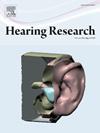Prevention and treatment of noise-induced hearing loss and cochlear synapse degeneration by potassium channel blockers in vivo
IF 2.5
2区 医学
Q1 AUDIOLOGY & SPEECH-LANGUAGE PATHOLOGY
引用次数: 0
Abstract
Noise can induce hearing loss. In particular, noise can induce cochlear synapse degeneration leading to hidden hearing loss, which is the most common type of hearing disorders in the clinic. Currently, there is no pharmacological treatment, especially no post-exposure (i.e., therapeutic) treatment available in the clinic. Here, we report that systemic administration of K+ channel blockers by intraperitoneal injection before or after noise exposure significantly ameliorated noise-induced hearing loss (NIHL) and cochlear synapse degeneration. After systemic administration of a general K+-channel blocker tetraethylammonium (TEA) before or after noise exposure, the noise-induced threshold elevation of auditory brainstem responses (ABRs) and reduction of suprathreshold responses were significantly attenuated. The impairment on the active cochlear mechanics measured by distortion product otoacoustic emission (DPOAE) was also reduced. The therapeutic effect was further improved as the post-exposure administration time extended. BK channel is a predominant K+ channel in the inner hair cell. We further found that post-exposure administration of a BK channel blocker GAL-021 could ameliorate NIHL and improved the hearing behavioral responses examined by acoustic startle response (ASR). Finally, both TEA and GAL-021 significantly reduced noise-induced ribbon synapse degeneration. These findings demonstrate a promise of systemic administration of K+ channel blockers to treat synapse degeneration and NIHL after noise exposure, which currently is urgently required in the clinic.
体内钾通道阻滞剂防治噪声性听力损失和耳蜗突触变性
噪音会导致听力丧失。特别是噪声可诱发耳蜗突触变性,导致隐蔽性听力损失,这是临床上最常见的听力障碍类型。目前,没有药物治疗,特别是在临床上没有暴露后(即治疗性)治疗。在此,我们报告了在噪声暴露前后通过腹腔注射K+通道阻滞剂可显著改善噪声性听力损失(NIHL)和耳蜗突触变性。在噪声暴露前后系统给予普通K+通道阻滞剂四乙基铵(TEA)后,噪声诱导的听性脑干反应阈值升高和阈值以上反应降低显著减弱。畸变积耳声发射(DPOAE)测量的主动耳蜗力学损伤也有所降低。随着暴露后给药时间的延长,治疗效果进一步提高。BK通道是内毛细胞中主要的K+通道。我们进一步发现,暴露后给予BK通道阻滞剂GAL-021可以改善NIHL,并改善由声惊反应(ASR)检测的听力行为反应。最后,TEA和GAL-021均能显著降低噪声诱导的带状突触变性。这些发现表明,K+通道阻滞剂在治疗噪声暴露后的突触变性和NIHL方面有很大的前景,这是目前临床迫切需要的。
本文章由计算机程序翻译,如有差异,请以英文原文为准。
求助全文
约1分钟内获得全文
求助全文
来源期刊

Hearing Research
医学-耳鼻喉科学
CiteScore
5.30
自引率
14.30%
发文量
163
审稿时长
75 days
期刊介绍:
The aim of the journal is to provide a forum for papers concerned with basic peripheral and central auditory mechanisms. Emphasis is on experimental and clinical studies, but theoretical and methodological papers will also be considered. The journal publishes original research papers, review and mini- review articles, rapid communications, method/protocol and perspective articles.
Papers submitted should deal with auditory anatomy, physiology, psychophysics, imaging, modeling and behavioural studies in animals and humans, as well as hearing aids and cochlear implants. Papers dealing with the vestibular system are also considered for publication. Papers on comparative aspects of hearing and on effects of drugs and environmental contaminants on hearing function will also be considered. Clinical papers will be accepted when they contribute to the understanding of normal and pathological hearing functions.
 求助内容:
求助内容: 应助结果提醒方式:
应助结果提醒方式:


